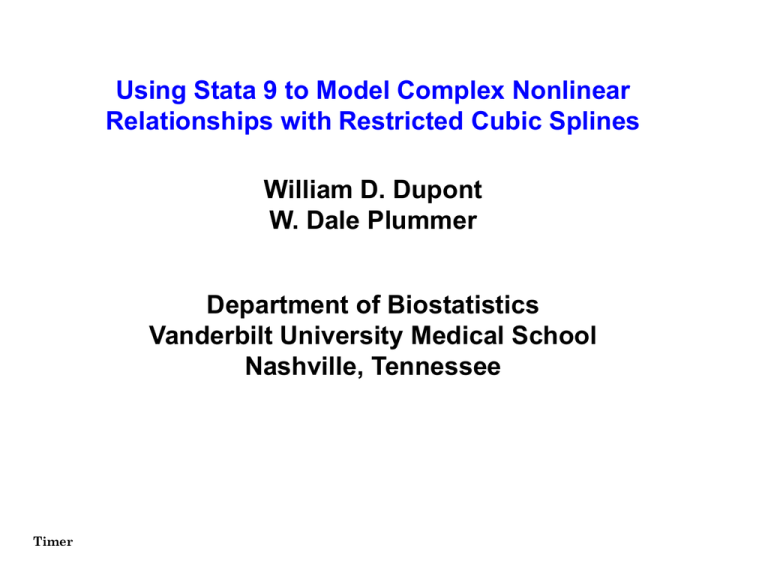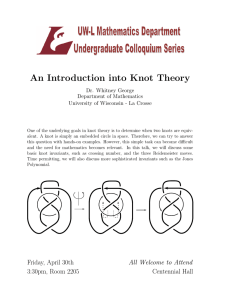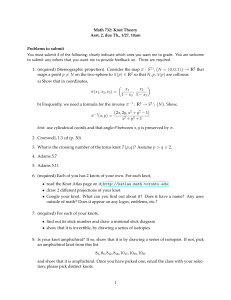Using Stata 9 to Model Complex Nonlinear William D. Dupont
advertisement

Using Stata 9 to Model Complex Nonlinear
Relationships with Restricted Cubic Splines
William D. Dupont
W. Dale Plummer
Department of Biostatistics
Vanderbilt University Medical School
Nashville, Tennessee
Timer
Restricted Cubic Splines (Natural Splines)
Given
{(xi , yi ) : i = 1,
, n}
We wish to model yi as a function of xi using a flexible
non-linear model.
In a restricted cubic spline model we introduce k
knots on the x-axis located at t1 , t2 , ,tk. We select a
model of the expected value of y given x that is
linear before t1 and after tk .
consists of piecewise cubic polynomials between
adjacent knots (i.e. of the form ax 3 + bx 2 + cx + d )
continuous and smooth at each knot, with
continuous first and second derivatives.
t1
t2
t3
Example of a restricted cubic spline with three knots
Given x and k knots, a restricted cubic spline
can be defined by
y = a + x1b1 + x2b2 +
+ x k - 1bk - 1
where
x1 = x
3
x j = (x - t j - 1 )+ -
(x -
3
tk - 1 +
)
(tk - t j - 1 ) + (x - ) (tk- 1 - t j - 1 )
(tk - tk - 1 )
for j = 2, … , k – 1
ìu: u >0
(u ) + = í
î0: u£0
3
tk +
(tk - tk - 1 )
These covariates are
functions of x and the knots but are
independent of y.
x1 = x and hence the linear hypothesis is tested
by b2 = b3 = = bk- 1 = 0 .
Stata programs to calculate x1 , , x k - 1 are
available on the web.
(Run findit spline from within Stata.)
One of these is rc_spline
rc_spline xvar [fweight] [if exp] [in range]
[,nknots(#) knots(numlist)]
generates the covariates x1 ,
x = xvar
, x k - 1 corresponding to
nknots(#) option specifes the number of knots
(5 by default)
knots(numlist) option specifes the knot locations
This program generates the spline covariates named
_Sxvar1 = xvar
_Sxvar2
_Sxvar3
.
.
.
Default knot locations are placed at the quantiles of the
x variable given in the following table (Harrell 2001).
Number
of knots
k
Knot locations expressed in quantiles
of the x variable
3
0.1
0.5
0.9
4
0.05
0.35
0.65
0.95
5
0.05
0.275
0.5
0.725
0.95
6
0.05
0.23
0.41
0.59
0.77
0.95
7
0.03
0.183
0.342
0.5
0.658
0.817
0.98
SUPPORT Study
A prospective observational study of hospitalized patients
Lynn & Knauss: "Background for SUPPORT."
J Clin Epidemiol 1990; 43: 1S - 4S.
los
= length of stay in days.
meanbp
= baseline mean arterial blood pressure
ì 1: Patient died in hospital
hospdead = í
î 0: Patient discharged alive
250
200
150
100
0
50
25
50
75
100
125
150
Mean Arterial Blood Pressure (mm Hg)
175
. gen log_los = log(los)
. rc_spline meanbp
number of knots =
value of knot 1 =
value of knot 2 =
value of knot 3 =
value of knot 4 =
value of knot 5 =
5
47
66
78
106
129
Define 4 spline covariates associated with
5 knots at their default locations.
The covariates are named
_Smeanbp1
_Smeanbp2
_Smeanbp3
_Smeanbp4
. gen log_los = log(los)
. rc_spline meanbp
number of knots =
value of knot 1 =
value of knot 2 =
value of knot 3 =
value of knot 4 =
value of knot 5 =
5
47
66
78
106
129
Regress log_los against all
variables that start with the
letters _S. That is, against
_Smeanbp1
_Smeanbp2
_Smeanbp3
_Smeanbp4
. regress log_los _S*
Source |
SS
df
MS
-------------+-----------------------------Model | 60.9019393
4 15.2254848
Residual | 610.872879
991 .616420665
-------------+-----------------------------Total | 671.774818
995 .675150571
Number of obs
F( 4,
991)
Prob > F
R-squared
Adj R-squared
Root MSE
=
=
=
=
=
=
996
24.70
0.0000
0.0907
0.0870
.78512
-----------------------------------------------------------------------------log_los |
Coef.
Std. Err.
t
P>|t|
[95% Conf. Interval]
-------------+---------------------------------------------------------------_Smeanbp1 |
.0296009
.0059566
4.97
0.000
.017912
.0412899
_Smeanbp2 | -.3317922
.0496932
-6.68
0.000
-.4293081
-.2342762
_Smeanbp3 |
1.263893
.1942993
6.50
0.000
.8826076
1.645178
_Smeanbp4 | -1.124065
.1890722
-5.95
0.000
-1.495092
-.7530367
_cons |
1.03603
.3250107
3.19
0.001
.3982422
1.673819
------------------------------------------------------------------------------
. test _Smeanbp2
( 1)
( 2)
( 3)
_Smeanbp3 _Smeanbp4
_Smeanbp2 = 0
_Smeanbp3 = 0
_Smeanbp4 = 0
F(
3,
991) =
Prob > F =
Test the null hypothesis
that there is a linear
relationship between
meanbp and log_los.
30.09
0.0000
is the estimated expected
value of log_los under this model.
y_hat
. predict y_hat, xb
Graph a scatterplot of log_los vs. meanbp
together with a line plot of the expected
log_los vs. meanbp.
. scatter log_los meanbp ,msymbol(Oh)
>
|| line y_hat meanbp
>
, xlabel(25 (25) 175) xtick(30 (5) 170) clcolor(red)
>
clwidth(thick) xline(47 66 78 106 129, lcolor(blue))
>
ylabel(`yloglabel', angle(0)) ytick(`ylogtick')
>
ytitle("Length of Stay (days)")
>
legend(order(1 "Observed" 2 "Expected")) name(knot5, replace)
///
///
///
///
///
///
200
100
80
60
40
20
10
8
6
4
25
50
75
100
125
150
Mean Arterial Blood Pressure (mm Hg)
Observed
Expected
175
. drop _S* y_hat
. rc_spline meanbp, nknots(7)
number of knots = 7
value of knot 1 = 41
value of knot 2 = 60
value of knot 3 = 69
value of knot 4 = 78
value of knot 5 = 101.3251
value of knot 6 = 113
value of knot 7 = 138.075
Define 6 spline covariates
associated with 7 knots at
their default locations.
. regress log_los _S*
{ Output omitted }
. predict y_hat, xb
. scatter log_los meanbp ,msymbol(Oh)
>
|| line y_hat meanbp
>
, xlabel(25 (25) 175) xtick(30 (5) 170) clcolor(red)
>
clwidth(thick) xline(41 60 69 78 101 113 138, lcolor(blue))
>
ylabel(`yloglabel', angle(0)) ytick(`ylogtick')
>
ytitle("Length of Stay (days)")
>
legend(order(1 "Observed" 2 "Expected")) name(setknots, replace)
///
///
///
///
///
///
200
100
80
60
40
20
10
8
6
4
25
50
75
100
125
150
Mean Arterial Blood Pressure (mm Hg)
Observed
Expected
175
. drop _S* y_hat
. rc_spline meanbp, nknots(7) knots(40(17)142)
number of knots = 7
value of knot 1 = 40
value of knot 2 = 57
value of knot 3 = 74
Define 6 spline covariates
value of knot 4 = 91
associated with 7 knots at
value of knot 5 = 108
value of knot 6 = 125
evenly spaced locations.
value of knot 7 = 142
. regress log_los _S*
{ Output omitted }
. predict y_hat, xb
. scatter log_los meanbp ,msymbol(Oh)
>
|| line y_hat meanbp
>
, xlabel(25 (25) 175) xtick(30 (5) 170) clcolor(red)
>
clwidth(thick) xline(40(17)142, lcolor(blue))
>
ylabel(`yloglabel', angle(0)) ytick(`ylogtick')
>
ytitle("Length of Stay (days)")
>
legend(order(1 "Observed" 2 "Expected")) name(setknots, replace)
///
///
///
///
///
///
200
100
80
60
40
20
10
8
6
4
25
50
75
100
125
150
Mean Arterial Blood Pressure (mm Hg)
Observed
Expected
175
200
100
80
60
40
20
10
8
6
4
25
50
75
100
125
150
Mean Arterial Blood Pressure (mm Hg)
Observed
Expected
175
. drop _S* y_hat
. rc_spline meanbp, nknots(7)
{ Output omitted }
. regress log_los _S*
{ Output omitted }
. predict y_hat, xb
. predict se, stdp
Define se to be the standard
error of y_hat.
Define lb and ub to be the lower
and upper bound of a 95%
confidence interval for y_hat.
. generate lb = y_hat - invttail(_N-7, 0.025)*se
. generate ub = y_hat + invttail(_N-7, 0.025)*se
. twoway rarea lb ub meanbp , bcolor(gs6) lwidth(none)
>
|| scatter log_los meanbp ,msymbol(Oh) mcolor(blue)
>
|| line y_hat meanbp, xlabel(25 (25) 175) xtick(30 (5) 170)
>
clcolor(red) clwidth(thick) ytitle("Length of Stay (days)")
>
ylabel(`yloglabel', angle(0)) ytick(`ylogtick') name(ci,replace)
>
legend(rows(1) order(2 "Observed" 3 "Expected" 1 "95% CI" ))
This twoway plot includes an rarea plot of the
shaded 95% confidence interval for y_hat.
///
///
///
///
///
200
100
80
60
40
20
10
8
6
4
25
50
75
100
125
150
Mean Arterial Blood Pressure (mm Hg)
Observed
Expected
95% CI
175
. predict rstudent, rstudent
Define rstudent to be the
studentized residual.
Plot a lowess regression curve of
rstudent against meanbp
. lowess rstudent meanbp
>
, yline(-2 0 2) msymbol(Oh) rlopts(clcolor(green) clwidth(thick))
>
xlabel(25 (25) 175) xtick(30 (5) 170)
///
///
-2
0
2
4
Lowess smoother
25
bandwidth = .8
50
75
100
125
150
Mean Arterial Blood Pressure (mm Hg)
175
1
30
.9
.8
Hospital Mortality Rate
25
20
15
10
.7
.6
.5
.4
.3
.2
5
.1
0
0
20
40
60
80
100
120
140
Mean Arterial Blood Pressure (mm Hg) ...
Total
Deaths
160
Mortality Rate
180
Simple logistic regression of
hospdead against meanbp
. logistic hospdead meanbp
Logistic regression
Log likelihood = -545.25721
Number of obs
LR chi2(1)
Prob > chi2
Pseudo R2
=
=
=
=
996
29.66
0.0000
0.0265
-----------------------------------------------------------------------------hospdead | Odds Ratio
Std. Err.
z
P>|z|
[95% Conf. Interval]
-------------+---------------------------------------------------------------meanbp |
.9845924
.0028997
-5.27
0.000
.9789254
.9902922
-----------------------------------------------------------------------------. predict p,p
. line p meanbp, ylabel(0 (.1) 1) ytitle(Probabilty of Hospital Death)
1
.9
.8
.7
.6
.5
.4
.3
.2
0
.1
0
50
100
150
Mean Arterial Blood Pressure (mm Hg)
200
. drop _S* p
. rc_spline meanbp
number of knots =
value of knot 1 =
value of knot 2 =
value of knot 3 =
value of knot 4 =
value of knot 5 =
5
47
66
78
106
129
. logistic hospdead _S*, coef
Logistic regression
Log likelihood = -498.65571
Logistic regression of hospdead
against spline covariates for
meanbp with 5 knots.
Spline covariates are significantly
different from zero
Number of obs
LR chi2(4)
Prob > chi2
Pseudo R2
=
=
=
=
996
122.86
0.0000
0.1097
-----------------------------------------------------------------------------hospdead |
Coef.
Std. Err.
z
P>|z|
[95% Conf. Interval]
-------------+---------------------------------------------------------------_Smeanbp1 | -.1055538
.0203216
-5.19
0.000
-.1453834
-.0657241
_Smeanbp2 |
.1598036
.1716553
0.93
0.352
-.1766345
.4962418
_Smeanbp3 |
.0752005
.6737195
0.11
0.911
-1.245265
1.395666
_Smeanbp4 | -.4721096
.6546662
-0.72
0.471
-1.755232
.8110125
_cons |
5.531072
1.10928
4.99
0.000
3.356923
7.705221
------------------------------------------------------------------------------
. test _Smeanbp2 _Smeanbp3 _Smeanbp4
( 1)
( 2)
( 3)
_Smeanbp2 = 0
_Smeanbp3 = 0
_Smeanbp4 = 0
chi2( 3) =
Prob > chi2 =
80.69
0.0000
We reject the null hypothesis
that the log odds of death is a
linear function of mean BP.
. predict p,p
. predict logodds, xb
. predict stderr, stdp
Estimated Statistics at Given Mean BP
p
= probability of death
logodds = log odds of death
stderr = standard error of logodds
(lodds_lb, lodds_ub) = 95% CI for logodds
(ub_l, ub_p)
= 95% CI for p
. generate lodds_lb = logodds - 1.96*stderr
. generate lodds_ub = logodds + 1.96*stderr
. generate ub_p = exp(lodds_ub)/(1+exp(lodds_ub))
. generate lb_p = exp(lodds_lb)/(1+exp(lodds_lb))
. by meanbp: egen rate = mean(hospdead)
rate
= proportion of
deaths at each
blood pressure
. twoway rarea lb_p ub_p meanbp, bcolor(gs14)
>
|| line p meanbp, clcolor(red) clwidth(medthick)
>
|| scatter rate meanbp, msymbol(Oh) mcolor(blue)
>
, ylabel(0 (.1) 1, angle(0)) xlabel(20 (20) 180)
>
xtick(25 (5) 175) ytitle(Probabilty of Hospital Death)
>
legend(order(3 "Observed Mortality"
>
2 "Expected Mortality" 1 "95% CI") rows(1))
///
///
///
///
///
///
1
.9
.8
.7
.6
.5
.4
.3
.2
.1
0
20
40
60
80
100
120
140
Mean Arterial Blood Pressure (mm Hg)
Observed Mortality
Expected Mortality
160
180
95% CI
We can use this model to calculate mortal odds ratios
for patients with different baseline blood pressures.
. list _S*
///
>
if (meanbp==60 | meanbp==90 | meanbp==120) & meanbp ~= meanbp[_n-1]
+-------------------------------------------+
| _Smean~1
_Smean~2
_Smean~3
_Smean~4 |
|-------------------------------------------|
178. |
60
.32674
0
0 |
575. |
90
11.82436
2.055919
.2569899 |
893. |
120
56.40007
22.30039
10.11355 |
+-------------------------------------------+
Logodds of death for patients with meanbp = 60
. lincom (5.531072
>
>
>
-(5.531072
>
+
+
60*_Smeanbp1 +
0*_Smeanbp3 +
.32674*_Smeanbp2
0 *_Smeanbp4)
+
90*_Smeanbp1 + 11.82436*_Smeanbp2
+ 2.055919*_Smeanbp3 + .2569899*_Smeanbp4)
Logodds of death for patients with meanbp = 90
///
///
///
///
( 1) - 30 _Smeanbp1 - 11.49762 _Smeanbp2 - 2.055919 _Smeanbp3 > .2569899 _Smeanbp4 = 0
-----------------------------------------------------------------------------hospdead | Odds Ratio
Std. Err.
z
P>|z|
[95% Conf. Interval]
-------------+---------------------------------------------------------------(1) |
3.65455
1.044734
4.53
0.000
2.086887
6.399835
------------------------------------------------------------------------------
Mortal odds ratio for patients with meanbp = 60 vs. meanbp = 90.
. lincom (5.531072
>
>
>
-(5.531072
>
+
120*_Smeanbp1 + 56.40007*_Smeanbp2
+ 22.30039*_Smeanbp3 + 10.11355*_Smeanbp4)
+
90*_Smeanbp1 + 11.82436*_Smeanbp2
+ 2.055919*_Smeanbp3 + .2569899*_Smeanbp4)
///
///
///
///
( 1) 30 _Smeanbp1 + 44.57571 _Smeanbp2 + 20.24447 _Smeanbp3 + 9.85656
> _Smeanbp4 = 0
-----------------------------------------------------------------------------hospdead | Odds Ratio
Std. Err.
z
P>|z|
[95% Conf. Interval]
-------------+---------------------------------------------------------------(1) |
2.283625
.5871892
3.21
0.001
1.379606
3.780023
------------------------------------------------------------------------------
Mortal odds ratio for patients with meanbp = 120 vs. meanbp = 90.
Stone CJ, Koo CY: Additive splines in statistics Proceedings
of the Statistical Computing Section ASA. Washington D.C.:
American Statistical Association, 1985:45-8.
Stata Software
Goldstein, R: srd15, Restricted cubic spline functions.
1992; STB-10: 29-32. spline.ado
Sasieni, P: snp7.1, Natural cubic splines. 1995; STB-24.
spline.ado
Dupont WD, Plummer WD: rc_spline from SSC-IDEAS
http://fmwww.bc.edu/RePEc/bocode/r
General Reference
Harrell FE: Regression Modeling Strategies: With
Applications to Linear Models, Logistic Regression, and
Survival Analysis. New York: Springer, 2001.
Cubic B-Splines
de Boor, C: A Practical Guide to Splines.
New York: Springer-Verlag 1978
Similar to restricted cubic splines
More complex
More numerically stable
Does not perform as well outside of the knots
Software
Newson, R: sg151, B-splines & splines parameterized
by values at ref. points on x-axis. 2000; STB-57: 20-27.
bspline.ado
nl – Nonlinear least-squares regression
Effective when you know the correct form of the
non-linear relationship between the dependent and
independent variable.
Has fewer post-estimation commands and predict
options than regress.
Conclusions
Restricted cubic splines can be used with any
regression program that uses a linear predictor
– e.g. regress, logistic, glm, stcox etc.
Can greatly increase the power of these methods to
model non-linear relationships.
Simple technique that is easy to use and easy to
explain.
Can be used to test the linearity assumption of
generalized linear regression models.
Allows users to take advantage of the very mature
post-estimation commands associated with
generalized linear regression programs to produce
sophisticated graphics and residual analyses.



